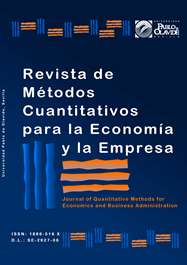The elasticity of demand for Ecuadorian exports in the dollarized period
DOI:
https://doi.org/10.46661/revmetodoscuanteconempresa.5440Keywords:
exports, ARDL, Error Correction Model, VECMAbstract
Exports are a determining variable of the national product so the objective is to perform quantitative estimations, first taking them in an aggregate manner, then by group of products and finally by the main destination market, considering here the four main ones constituted by the US, Chile, Peru and Colombia. Then, the elasticities are found by co-integration models ARDL and VECM, while for the cases of absence of a common stochastic trend the short-term coefficients are obtained through VAR models. At the end, short and long-term ARDL estimates are also made with variables that present a different order of integration, according to the methodology of Pesaran, Shin and Smith (2001), based on the bounds testing approach. The main findings show that in the short term most coefficients are not significant. On the contrary, in the long-term foreign income and the price index are always significant except for Peru. The variables of real exchange rate and volatility are significant only in certain regressions depending on the model considered, although sometimes with unexpected signs. Finally, the regression involving Colombia is totally inconclusive.
Downloads
References
Abbas, M. (2012). Merchandise Export Demand Function For Egypt: a Panel Data Analysis, 1990-2008. Applied Econometrics and International Development, 12(1), 107-116.
Acosta, A., & Cajas, J. (2020). Ecuador... 20 años no es nada: a dos décadas del mito dolarizador. Revista Economía, 72(115), 15-32. https://doi.org/10.29166/economia.v72i115.2220
Belloc, M., & Di Maio, M. (2011). Survey of the Literature on Successful Strategies and Practices for Export Promotion by Developing Countries. Londres: International Growth Center.
Bernard, A.B., & Jensen, B.J. (2004). Why some firm export. The Review of Economic and Statistics, 86(2), 561-569.
Bredin, D., Fountas, S., & Murphy, E. (2003). An Empirical Analysis of Short-run and Long-run Irish Export Functions: Does exchange rate volatility matter? International Review of Applied Economics, 17, 193-208. https://doi.org/10.1080/0269217032000064053
Buzaushina, A. (2015). Trade elasticities in transition countries. International Economics and Economic Policy, 12, 309-335. https://doi.org/10.1007/s10368-014-0273-z
Cermeño, R. S., & Rivera, H. (2016). La demanda de importaciones y exportaciones de México en la era del TLCAN. Un enfoque de cointegración. El trimestre económico, 83(329), 127-147.
Demirhan, E., & Demirhan, B. (2015). The Dynamic Effect of Exchange-Rate Volatility on Turkish Exports: Parsimonious Error Correction Model Approach. Panoeconomicus, 62(4), 429-451. http://dx.doi.org/10.2298/PAN1504429D
Engle, R.F., & Yoo, B.S. (1987). Forecasting and testing in co-integrated systems. Journal of Econometrics, 35(1), 143-159. doi:https://doi.org/10.1016/0304-4076(87)90085-6
Engle, R.F., Hendry, D.F., & Richard, J.-F. (1983). Exogeneity. Econometrica, 51(2), 277-304. https://doi.org/1911990
Fares, F., & Zack, G. (2018). Un análisis de la restricción externa de la Argentina a través de sus elasticidades agregadas y sectoriales de comercio exterior. LIII Reunión Anual (pp. 1-35). Asociación Argentina de Economía Política.
Giles, D. (13 de junio de 2013). ARDL Models - Part II - Bounds Test. Econometrics Beat: David Giles´ Blog: https://davegiles.blogspot.com/2013/06/ardl-models-part-ii-bounds-tests.html
Narayan, S., & Narayan, P.K. (2010). Estimating import and export demand elasticities for Mauritius and South Africa. Australian Economic Papers, 49(3), 241-252. https://doi.org/10.1111/j.1467-8454.2010.00399.x
Organización de los Estados Americanos (2020). Países Andinos - Union Europea Antecedentes y Negociaciones. Obtenido de Sistema de Información sobre Comercio Exterior - Brindando información comercial a gobiernos y PYMEs: http://sice.oas.org/TPD/AND_EU/AND_EU_s.ASP
Paredes, G.J. (2017). Ecuador: ¿por qué salir de la dolarización? Cepal Review, 121(1), 149-167.
Pesaran, H.M., Shin, Y., & Smith, R.J. (2001). Bounds Testing Approaches to the Analysis of Level Relationships. Journal of Applied Econometrics, 16(3), 289-326.
Sawore, A. (2016). Determinants of Export Trade in Econometric Study with Special Reference to Ethiopia. International Journal of Science and Research, 5(12), 132-137.
Simoes, A.J., & Hidalgo, C.A. (2011). The Economic Complexity Observatory: An Analytical Tool for Understanding the Dynamics of Economic Development. Workshop at the Twenty-Fifth Conference on Artificial Intelligence AAAI (pp. 39-42). Cambridge, MA: MIT Media Lab, Macro Connections.
Sultan, Z.A. (2012). Estimation of India's export demand function: The bound test approach. African Journal of Business Management, 6(45), 11266-11272. https://doi.org/10.5897/AJBM12.356
Thaver, R.L., & Bova, C. (2014). An estimation of Ecuador's export demand function with the US. The International Journal of Business and Finance Research, 8(1), 89-102.
Verheyen, F. (2014). The stability of German export demand equations - have german exports suffered from the strength of the euro? International Economics and Economic Policy, 11, 529-548. https://doi.org/10.1007/s10368-013-0260-9
Villalba, M. (2019). Dos décadas de dolarización, ¿qué hemos aprendido sobre este esquema monetario? En M. Beltrani, C. Cordero, J. Cuattromo, A. Chiriboga, A. Dahik, C. de la Torre Muñoz, … A. Lieutier. Dolarización: dos décadas después. Consorcio de Gobiernos Autónomos Provinciales del Ecuador - CONGOPE.
Wasbrum, W., Palma, M., Vasquez, T., Barragan, S., & Landivar, J. (2016). Las Negociaciones entre la Comunidad Andina de Naciones y la Unión Europea y su Impacto en la Balanza Comercial Ecuatoriana 2001 al 2012. Journal of Economics and Development Studies, 5(3), 68-78. https://doi.org/10.15640/jeds.v5n3a8
Wooldridge, J. M. (2015). Introducción a la Econometría (5ª ed.). México, D.F.: Cengage Learning.
Downloads
Published
How to Cite
Issue
Section
License

This work is licensed under a Creative Commons Attribution-ShareAlike 4.0 International License.
Submission of manuscripts implies that the work described has not been published before (except in the form of an abstract or as part of thesis), that it is not under consideration for publication elsewhere and that, in case of acceptance, the authors agree to automatic transfer of the copyright to the Journal for its publication and dissemination. Authors retain the authors' right to use and share the article according to a personal or instutional use or scholarly sharing purposes; in addition, they retain patent, trademark and other intellectual property rights (including research data).
All the articles are published in the Journal under the Creative Commons license CC-BY-SA (Attribution-ShareAlike). It is allowed a commercial use of the work (always including the author attribution) and other derivative works, which must be released under the same license as the original work.
Up to Volume 21, this Journal has been licensing the articles under the Creative Commons license CC-BY-SA 3.0 ES. Starting from Volume 22, the Creative Commons license CC-BY-SA 4.0 is used.










